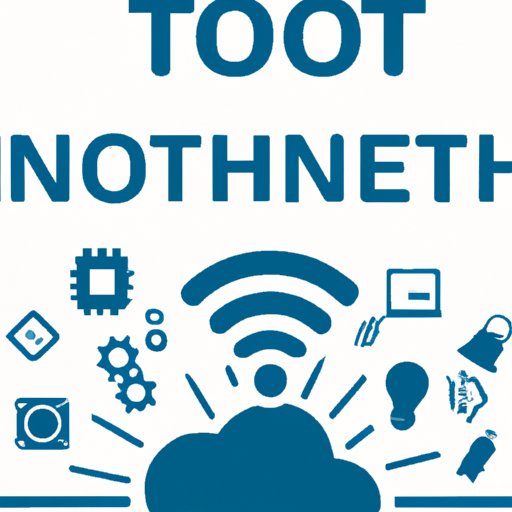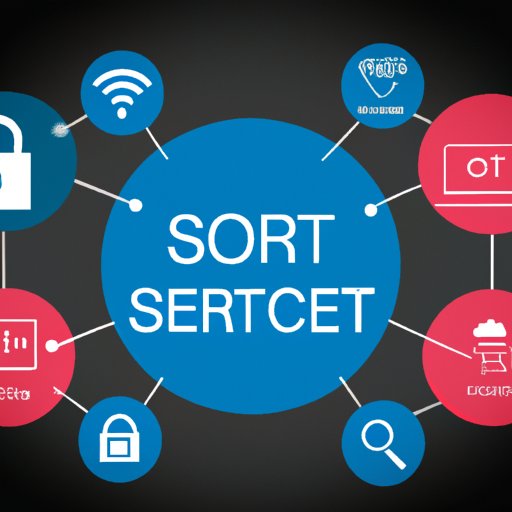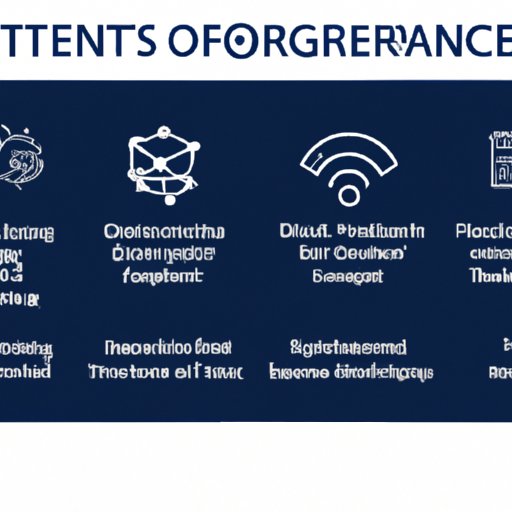Introduction
The Internet of Things (IoT) is one of the most talked-about topics in the world of technology. But what does it actually mean? This article will provide a comprehensive guide to understanding IoT, exploring its benefits and risks for businesses, and examining some of the potential uses and applications.
Exploring the Basics of IoT
What is IoT and How Does it Work?
The Internet of Things (IoT) is a network of physical objects or “things” that are connected to the internet. These things can be anything from consumer electronics and home appliances to industrial machines and vehicles. They all have sensors that collect data about their environment and send this data back to the cloud. This data can then be used to improve efficiency, reduce costs, and enhance customer service.
IoT devices use various communication protocols, such as Bluetooth and Wi-Fi, to send and receive data. The data is then stored in the cloud, where it can be accessed by developers and analyzed to gain insights into how the device is being used.
Different Types of IoT
There are several different types of IoT devices, each with its own set of features and capabilities. Some of the most common types of IoT include:
- Consumer electronics, such as smart TVs and home automation systems;
- Industrial machines, such as manufacturing robots and automated assembly lines;
- Vehicles, such as autonomous cars and drones;
- Sensors, such as temperature and humidity sensors;
- Wearable devices, such as fitness trackers and medical monitors.
An Overview of IoT: What Are Its Benefits for Businesses?
Cost Savings
One of the key benefits of IoT is cost savings. By connecting devices to the internet, businesses can automate processes, which reduces the need for manual labor and decreases operational costs. Additionally, IoT-enabled devices can detect problems before they become major issues, which helps to reduce downtime and maintenance costs.
Increased Efficiency
IoT devices can also help to increase efficiency. By collecting data from connected devices, businesses can identify opportunities for improvement and optimize their processes. For example, manufacturing companies can use IoT sensors to monitor production levels in real-time and make adjustments when necessary in order to maximize output.
Improved Customer Service
The data collected by IoT devices can also be used to improve customer service. Companies can use this data to gain insights into customer behavior and preferences, which can then be used to create more personalized experiences and targeted marketing campaigns. Additionally, IoT devices can be used to provide customers with real-time support, such as remote troubleshooting and proactive maintenance.

A Comprehensive Guide to IoT: The Potential Uses and Applications
Industrial IoT
Industrial IoT refers to the use of IoT devices in industrial settings, such as factories and warehouses. IoT devices can be used to monitor machinery, track inventory levels, and optimize production processes. Additionally, IoT-enabled sensors can detect anomalies and alert workers to potential problems before they become major issues.
Smart Homes
Smart homes refer to the use of IoT devices in residential settings. These devices can be used to control lights, adjust temperatures, lock doors, and even monitor activity. Additionally, smart home devices can be used to provide homeowners with real-time insights into their energy usage, helping them to reduce their energy bills.
Wearable Technology
Wearable technology refers to the use of IoT devices in wearable form factors, such as watches and fitness trackers. These devices can be used to monitor health and fitness metrics, track location, and even detect falls. Additionally, wearable devices can be used to provide users with real-time alerts, such as weather warnings and traffic updates.
IoT in Action: Examples of Real-World Implementations
Automotive Industry
The automotive industry has been quick to embrace IoT technologies. Vehicle manufacturers are increasingly using IoT-enabled sensors to monitor performance, detect potential problems, and provide drivers with real-time feedback. Additionally, many cars now come equipped with connected services, such as navigation systems and roadside assistance.
Healthcare Industry
The healthcare industry is also taking advantage of IoT technologies. Hospitals and clinics are using IoT-enabled devices to monitor patient vitals, track medical equipment, and improve patient care. Additionally, wearables are being used to provide patients with real-time feedback on their health and fitness.
Retail Industry
Retailers are also leveraging the power of IoT. Retail stores are using IoT-enabled sensors to track inventory levels, monitor customer behavior, and provide shoppers with personalized experiences. Additionally, many retailers are now offering connected services, such as mobile payment systems and interactive displays.

IoT Security: Understanding the Risks and Protecting Your Data
Common Security Risks
One of the main concerns with IoT is security. As more devices become connected to the internet, the risk of cyberattacks increases. Common security risks include malware, data breaches, and unauthorized access. Additionally, many IoT devices lack basic security measures, such as encryption and authentication.
Strategies for Securing IoT Data
To protect against these risks, it’s important to have a comprehensive IoT security strategy. This should include measures such as encrypting data, implementing access controls, and regularly updating software. Additionally, businesses should take steps to ensure that their IoT devices are securely configured and monitored for suspicious activity.
Conclusion
Summary of Main Points
In conclusion, the Internet of Things (IoT) is a network of physical objects that are connected to the internet. IoT devices can be used to automate processes, increase efficiency, and improve customer service. Additionally, there are several potential uses and applications for IoT, including industrial IoT, smart homes, and wearable technology. However, it’s important to understand the security risks associated with IoT and take steps to protect your data.
Final Thoughts on IoT
The Internet of Things has the potential to revolutionize the way we do business. With the right strategy and implementation, businesses can reap the benefits of IoT while minimizing the risks. Now is the time to start exploring the possibilities of IoT and taking advantage of the opportunities it presents.
(Note: Is this article not meeting your expectations? Do you have knowledge or insights to share? Unlock new opportunities and expand your reach by joining our authors team. Click Registration to join us and share your expertise with our readers.)
